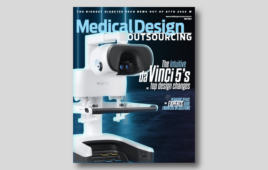
A Minnetronix engineer evaluates a control board for an electroporation system. [Photo courtesy of Minnetronix]
Macro-scale electroporation energy manipulates cellular behavior for effective drug delivery.
Saeid Movahed and Daniel Friedrichs, Minnetronix Medical
When applied to tissue, electric fields can enable precise and selective ablation effects by manipulating cellular-scale electrical properties. One effect, called electroporation or electropermeabilization, has many therapeutic and diagnostic applications including tumor ablation and intercellular delivery of DNA, RNA, protein and other cargo.
The intercellular space is separated from the outside environment by phospholipid bilayer (cell membrane), which is an electrically polarized membrane made of lipid molecules. Transmembrane potential (TMP) — the inherent difference between electric potentials on the two sides of the cell membrane — can be manipulated by external fields. This discontinuity in the electric potential is caused by the ability of the cell membrane to act as a capacitor, the difference between intracellular and extracellular conductivities, and the existence of an electric current in the cell membrane due to ion pumps and ion channels.
Presence of an externally applied electric pulse near the cell will alter this transmembrane potential, which consequently affects the membrane structure. When the applied electric field is strong enough, it will significantly disturb the cell membrane, creating artificial nanopores.
Nanopore creation
The energy minimum principle can be used to explain nanopore creation in the cell membrane during the electroporation. Based on this theory, the pores on the cell membrane can be either hydrophobic or hydrophilic.
Thermal fluctuation will cause gaps in the lipid bilayer of the membrane (hydrophobic pore). These pores start to grow under the stress from the elevated TMP enhanced by an external electric field. There is a threshold value of the TMP (0.5 ~ 1 V) at which the hydrophobic pores start to be converted to the hydrophilic pores (or converted pores) by lining the water-attracting heads of lipid molecules with the walls of the pores to minimize their energy.
Following the creation of the first hydrophilic nanopore, the TMP remains constant near the created hydrophilic nanopores and further increases of the external electric field will no longer affect the TMP. In this stage, increasing the electric field will intensify the electroporated area of the cell membrane (the area with hydrophilic nanopores) as well as radius of the created nanopores.

A Minnetronix engineer conducts board-level characterization of the output signal for an electroporation device. [Photo courtesy of Minnetronix]
Five steps of electroporation
The electroporation process can be categorized into five different steps:
- Induction: In this step, the TMP increases by the external electric field until it reaches its critical value. This step usually takes less than one microsecond.
- Expansion: The number and radius of the created nanopores continuously increase while the TMP is maintained constant above its threshold value. The time span of this step is affected by the shape and the duration of the electric pulses and is usually in the range of microseconds to milliseconds.
- Stabilization: This step initiates when the external electric field, and consequently the TMP, decreases to a subcritical value while the nanopores still exist in the cell membrane.
- Resealing: Upon removal of the external electric field, the resealing process of the cell membrane starts, which usually spans from seconds to minutes.
- Memory: After the resealing step, some more resilient changes usually remain in the cell membrane for minutes to hours.
Therapeutic and diagnostic applications of elecroporation
Nanopores created artificially in the cell membrane by electroporation can be permanent or temporary based on the intensity and the duration of the applied external electric pulse(s). For low and short-duration electric fields, the created nanopores can re-seal themselves by removing the applied electrical field, and hence, the electroporation process will be reversible.
However, strong-intensity and long-duration electric fields can generate permanent nanopores and cause irreversible damage to the cell membrane. In the irreversible electroporation, the expansion step continues until they permanently damage the cell membrane and consequently kill the cell, a property which can be beneficially harnessed for tumor ablation, as an example.
These reversible and irreversible electroporation processes have numerous therapeutic and diagnostic applications.
As an example, reversible electroporation can be used to deliver chemotherapeutics into cancerous cells. The resulting temporary nanopores in the cell membrane are an efficient pathway to transit drugs, ions or even futuristic nanosensors into cells.
Irreversible electroporation can be used to permanently damage the membrane structure and kill cells such as malignant tumors. Here, the nanopores are permanent and cannot reseal themselves, which kills the cells and ablates the targeted area.
Electroporation device development
Design and fabrication of electrodes and pulse generators, along with finding optimum arrangements of electrodes around the targeted area, are among the most challenging bottlenecks of cell electroporation device development.
The effectiveness and safety of electroporation depends on both biological characteristics of the targeted tissues and the electric pulse properties. These properties have been continuously improved by developing more efficient electric pulse delivery methods.

Saeid Movahed [Photo courtesy of Minnetronix]
Saeid Movahed, Ph.D., consults with Minnetronix Medical on design, verification and manufacturing of reversible and irreversible electroporation electrodes and pulse generators. Minnetronix develops device-specific requirements for electroporation for various tumor cells, electroporation-specific safety systems, and real-time therapy monitoring architectures.

Daniel Friedrichs [Photo courtesy of Minnetronix]
The opinions expressed in this post are the author’s only and do not necessarily reflect those of MedicalDesignandOutsourcing.com or its employees.




![A photo of the Medtronic GI Genius ColonPro polyp detection system flagging a potential sign of colon cancer during a colonoscopy. [Photo courtesy of Medtronic]](https://www.medicaldesignandoutsourcing.com/wp-content/uploads/2024/04/Medtronic-GI-Genius-doctors-268x170.jpg)